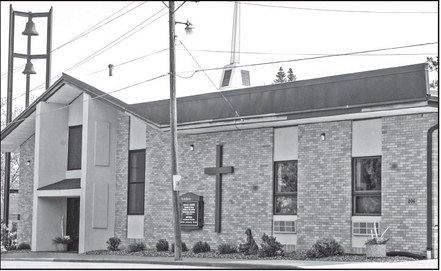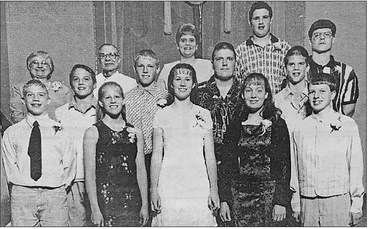Marathon City K-12 looks at buying church


By Kevin O’Brien
St. Matthew’s Lutheran Church in Marathon City has offered the local school district a chance to buy its soon-to-be-vacated building on Hemlock Street, opening up possibilities for a new early education center or alternative high school. Superintendent Rick Parks brought the offer to the school board’s attention at its May 14 meeting, touching off a discussion about whether or not it would be worth it for the district to invest in the property, which will become available after the congregation moves to the new church on CTH NN in October.
Parks said the question of what to do with the older church building came up as soon as the new one was being built, and after several discussions with church representatives, he believes there are ways the district could make use of the building.
“No decision has to be made tonight,” he told board members. “I just want you to be thinking about it.”
One of the options would be to use the building as an early childhood learning center, with four-year-old kindergarten being offered four or five days a week in the morning, regular kindergarten in the afternoon, and wraparound services throughout the rest of the day.
Parks said this could simplify the district’s early childhood programming, allowing for just one bus run and eliminating the need to alternate schedules based on the day of the week.
“It would be more consistent and probably be a better learning environment for the children having it five days a week,” he said.
Parks said he’s also had conversations with a neighboring district and CESA 9 about using the building as an alternative high school for students who struggle to learn in a traditional classroom environment. Right now, he said Marathon sends several of its students to
See CHURCH/ page 2
Rick Parks Church
Continued from page 1
an alternative high school in Merrill, which makes money off the program by accepting students from multiple districts in the area.
If Marathon were to pursue a similar program, Parks said CESA 9 may be interested in contributing financially.
Taking on the additional building could also free up space at the district’s existing schools, Parks said, whether its classrooms or offices.
The appraised value of the church is $448,000, according to an appraisal done by the church, but the district will not necessarily be asked to pay that amount, he said.
“It could be a little more; it could be a little less,” he said, noting that the appraised value came in at about half of what the initial estimate was eight months ago.
Still, he said the purchase is outside the budget’s current “budget parameters,” and it does not include the cost of remodeling the building or paying for the upkeep and maintenance. There are also staffing and transportation considerations to factor in, he said.
Parks said church leaders would really like to see the building be used for the benefit of the community, but that doesn’t mean the district has to be the one to buy it. When asked if any other parties were looking at buying the building, Parks said St. Matthew’s came to the district first.
“They would like to know what our thoughts are,” he said. “That’s my impression.”
Board member Lia Klumpyan asked what the impacts would be to Marathon Area Elementary if early childhood education were moved to a new building. Principal Max Wienke said it would allow for the expansion of the district’s fouryear- old kindergarten program and free up some classroom space at the elementary.
Board member Ted Knoeck said he has several questions at this point about the cost of remodeling and maintaining the building, along with the busing expenses and the logistics of having staff and potentially cooking services provided at another building. He said the district also needs to know ahead of time what additional costs there may be to make the old church suitable for classrooms. When it comes to the alternative high school idea, Knoeck said he would like to hear from the Merrill School District and its local police department about what kind of behavioral issues they’ve had.
“That has an impact on the community as well,” he said, questioning whether local police would have to devote extra time to the school.
Parks said he would talk to Merrill about its experience with having an alternative school, but he already knows that additional walls would need to be put in. The church does have a kitchen, but he’s not sure at this point if it would be adequate for the district’s needs.
“There are going to be added costs,” he said. “I don’t know what added revenue may help.”
Knoeck said he remembers about 20 years ago when an organization wanted to come into Marathon and set up something similar to an alternative high school, and “it did not go over well with the community.”
Board member Beth Seubert said she had her own questions and concerns about potentially using the building for early education, such as whether a playground could be established outside and whether students would have access to a gymnasium or library.
“Are we carting them back and forth so that they have some of the same learning availabilities?” she wondered.
Board president Jodi DeBroux said the district should really have a feasibility study done to address these questions before it decides whether or not to purchase the building.
At the same time, board member Paula Vesely wondered how long the board could expect the church to wait for an answer before it considers other options for selling the building.
Klumpyan said she’s been in the church several times, and says it’s a “very well-constructed building” with offices, a kitchen area and a spacious community room. Parks also noted there is some space to the east of the building that could be used for a small fenced-in playground area. Parks said he would bring back additional information on the topic for the board to consider at a future meeting.
“They just want to know if we’re interested in thinking about it some more and maybe doing something,” he said, referring to church representatives. “Or, do you need to have all of those answers before you say ‘Let’s think about it?’”
Insurance to be split 95/5
District employees will pay 5 percent of their health insurance premiums plans next year, with the district covering the remaining 95 percent, under a motion approved at the May 14 meeting. Last month, the board voted to switch from Aspirus Health to Security Health after Aspirus proposed a 12 percent hike in premiums for 2025-2026.
According to a chart provided to the board, under the 95/5 split, the district will pay as much as $26,800 per year for a wide-network family plan, with the employee paying about $1,400. On the low end, the district will pay about $11,000 for a narrow-network single plan that costs the employee close to $600.
Employees have until the end of this month to choose a plan for next year, so the total cost was unknown when the 95/5 split was approved. Parks said the cost will ultimately depend on how many employees switch from wide network to narrow network plans and vice versa. In picking the 95/5 option, board members said they did not want the employee contributions to erase the $1,700 raises approved in April.
In the worst-case scenario, in which every employee chose a wide-network plan, Parks said the district’s total cost for health insurance would be $1.2 million next year – up from $780,000 in 20172018 when the district paid 100 percent of the premiums. The actual cost will almost certainly be much lower, as not all employees will switch to the more expensive plans.
Knoeck said Marathon may never be able to compete with larger districts to the east when it comes to compensation packages, but the board remains committed to providing good insurance.
“I just think it’s very important that the employees understand the predicament that we’re in and what we’re facing with the increased costs, because they are not going down,” he said.
Other business
■ The board accepted the retirement of district administrative assistant Jackie Hanke and approved the hiring of Laura Miller as a junior high school track coach and Terry Tackes as a volunteer spring/ summer wellness coach. The following new teachers were hired: Halle Vardon, high school science; Hayley Zoesch, third grade; and Allison Wolfe, fifth grade. Corey Steen, a college student from Colby, was hired as a summer intern at the wellness center.
■ The board approved changes to the district’s OPEB (Other Post-Employment Benefits) plan, which will allow more money to go toward the retirement benefits of staff hired after July 1, 2008.
■ The board approved a couple of summer projects and curriculum purchases, including $5,600 for new tables, chairs and electrical work in the business education classrooms and $6,000 for the same items in the high school science classroom. On the curriculum side, the board approved a total of $24,000 for curriculum purchases and in-service training for revamping the science curriculum.
A proposal for $13,500 worth of art room purchases, including clay wheels, a slab roller and benches, was put on hold until the board has a better idea of the district’s end-ofthe- year budget.
■ The board voted to have the district contribute $4,900 toward a pair of FFA events planned for this summer, including the state convention, June 9-12, which will be attended by 15 students. The remainder of the money will be spent on an FFA officers retreat in Manitowish Waters, July 7-10.
■ Board members reviewed a list of potential summer projects, ranging from building a new second- floor office at MAES/MVA to installing new scoreboards and sound systems at the district’s athletic facilities. No formal recommendations were made.
SOMETHING TO CONSIDER - St. Matthew’s Lutheran Church in Marathon City will be moving to a new location later this year, leaving its existing building available for purchase. The local school district is considering options for buying the property.
STAFF PHOTO/KEVIN O’BRIEN




